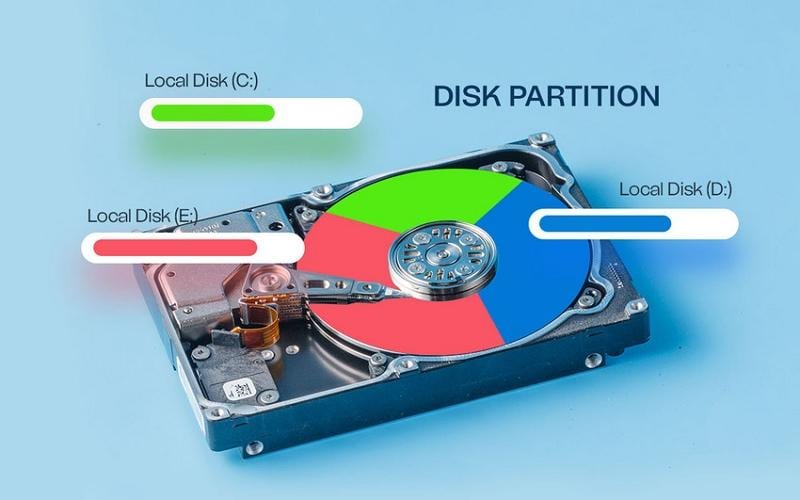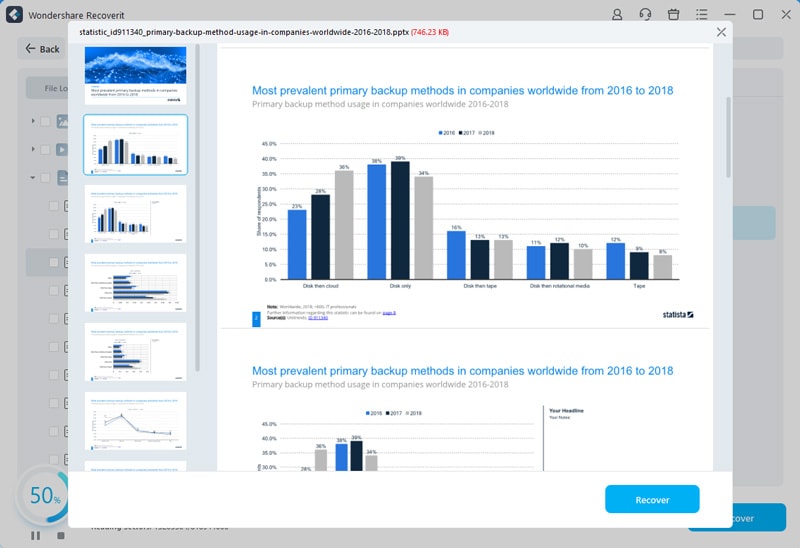Will partitioning my drive erase any data, or will it move to one side of the partition?- Quora
Many people partition a drive, thinking they won't lose data, realizing the opposite when it's too late.
Does partitioning a drive erase data? It depends. If you do it correctly, it shouldn't delete data, but you can also recover lost files with specialized software (unless you overwrite them with new entries). Let's see what drive partitioning is, when it does and doesn't erase data, and how to recover lost files and prevent data loss.
Table of Content
What Does It Mean to Partition a Drive?

- Primary – Typically containing an operating system, this partition (usually with the C letter) boots your computer. One drive can have a maximum of four, while only one remains active.
- Extended – One disk can have only one extended partition, a container for logical volumes. It doesn't have a drive letter, and you can't format it.
- Logical – Storing data requires a logical partition. You can create multiple on one disk to organize data better.
Whether you partition a drive to protect sensitive data (e.g., in case of a system crash, malware, or corruption), organize files, or switch between operating systems, understanding when your data will or won't stay safe is critical. Let's dive deeper into the matter.
Learn more: What is a partition
Does Partitioning a Drive Erase Data?
If you do it correctly, you won't lose data when creating partitions on a disk. Here's when partitioning a drive erases data and when it doesn't touch it.
When It Does
Accidentally deleting the wrong partition on a disk when trying to create a new one will erase data. Human error is the most prevalent reason partitioning a drive wipes data.
The same goes for formatting the wrong partition or an entire disk to add one or more logical volumes. However, a Quick Format rewrites the file system directory without permanently deleting data. If you don't overwrite the space with new files, you can restore it with data recovery software (more on that shortly).
When It Doesn't
Partitioning a drive doesn't erase data if you don't accidentally delete or reformat the wrong partition. Whether you extend or shrink an existing or create a new volume, you'll use the unallocated space on the disk.
The best part? Windows won't let you add a new or resize an existing volume if it contains data. That's an excellent measure for preventing data loss due to human error.
Let's see how to recover lost data from a partitioned drive if you've formatted or accidentally deleted a particular volume.
How To Recover Lost Data From a Partitioned Drive
Data recovery software is your best ally for recovering lost data in unexpected situations. Wondershare Recoverit is an excellent example of a reliable tool for retrieving data in 500+ scenarios, including drive formatting and incorrect partitioning.
- Recovers data from 2000+ storage media, including HDDs, SSDs, USB drives, SD cards, etc.
- Enables recovery of data lost due to formatting, partitioning, disk corruption, and more.
- Works with all popular file systems, such as NTFS, FAT, HFS+, and APFS, among others.

Here's how to use it to recover erase data after a drive partitioning.
- Download, install, and launch Wondershare Recoverit on your PC
- Select Hard Drives and Locations and click your newly partitioned disk.

- The software will perform quick and deep scans to find lost data. Leverage the search bar and filters (file size, type, status, tag, and modification time) to accelerate the process and retrieve specific files (unless you wish to save everything). You can pause or stop the scan anytime.

- Preview the recoverable files in full screen, click Select All (or tick the corresponding boxes), and hit Recover.

- Pick the target destination (preferably another volume) and click Recover.

Wondershare Recoverit has a 95% success rate and can restore data even after a system crash or accidental formatting during disk partitioning. It's a valuable addition to your toolkit because it offers a fail-safe if you unintentionally erase files.
Still, knowing how to avoid data loss is crucial. Here's how to keep your data safe when partitioning a drive.
How To Ensure You Don't Erase Data When Partitioning a Drive
Backing up your data before partitioning a drive is critical. Even if you do everything by the book, one unintentional click is all it takes to flush your efforts down the drain.
Here's how to create a backup using a built-in Windows feature:
- Go to Control Panel > Backup and Restore (Windows 7). Microsoft enabled backward compatibility on newer OS versions, so ignore the Windows 7 part.

- Click Set up backup.

- Click the drive you wish to back up before partitioning and hit Next.

- Click Let me choose to select the desired data and hit Next.

- Specify the folders and files for the backup and click Next.

- Click Save settings and run backup.

Now that your data is safe, it's time to partition your disk without worrying about data loss. You can do it with Disk Management, which lets you add new and resize, format, and delete existing partitions.
Here's how to partition a new drive without data:
- Right-click the Start button with the Windows logo and select Disk Management.
- Right-click the new drive's unallocated space and click New Simple Volume.

- Click Next when the wizard launches.

- The default value will be the maximum available size. Change it if you wish to add more than one partition, and click Next.

- Pick an available drive letter and hit Next.

- Select the desired file system, create a label, tick the Perform a quick format checkbox, and click Next.

- Review the settings and hit Finish.

Here's how to shrink a partition in Disk Management without losing data:
- Right-click the desired volume and select Shrink Volume.

- Click Next once the wizard launches and set the preferred value according to the available shrink space. Your data will stay safe because you can't exceed that threshold. Click Shrink > Finish.

You can now create a new simple volume with the unallocated space you got from shrinking the partition.
Here's how to extend a volume in Disk Management if it has adjacent unoccupied space:
- Right-click the desired partition and select Extend Volume. Disk Management will gray this option out if there's no unallocated space next to the chosen volume.

- Click Next when the wizard starts and set the preferred value. The maximum available space will be the default, but you can change it if you plan on adding another volume afterward. Click Next > Finish.

Conclusion
As you can see, partitioning a drive doesn't erase data when you leverage the trusted Disk Management. It doesn't let you resize volumes containing data below or over the available unallocated space.
Still, backing up data beforehand is essential because you might unintentionally delete or reformat the wrong volume when partitioning a drive. However, you can recover lost files with reliable tools like Wondershare Recoverit, even after formatting or accidentally deleting a partition.
FAQs
Will I lose data if I partition my hard drive?
You won't lose data if you partition your hard drive (unless you format or delete the wrong volume). However, you can retrieve lost files with data recovery software like Wondershare Recoverit.Is it a good idea to partition your hard drive?
Partitioning a hard drive helps organize and protect data in case of a system crash, corruption, or other expected situations. For instance, you can create a primary partition with your operating system and keep data safe in separate logical volumes.Does moving a partition erase data?
Moving a partition doesn't erase data. It only changes its forward and backward position on your drive, keeping data intact.Does deleting a partition erase data?
Deleting a partition wipes data, but it's not a permanent loss. It only removes that volume's reference, so Windows can't find the correct drive letter to look for data, making it inaccessible but not unrecoverable. You can retrieve it with specialized software like Wondershare Recoverit.How do I partition a drive without losing data?
Disk Management can help you partition a drive without data loss. It lets you use only unallocated space to add new or resize existing volumes. Additionally, it doesn't allow you to shrink or extend those volumes below or over the available unoccupied space.



 ChatGPT
ChatGPT
 Perplexity
Perplexity
 Google AI Mode
Google AI Mode
 Grok
Grok























